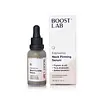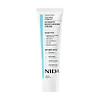What's inside
What's inside
 Key Ingredients
Key Ingredients

 Benefits
Benefits

 Ingredients Side-by-side
Ingredients Side-by-side

Loess Extract
Skin ConditioningCollagen Extract
Skin ConditioningPropanediol
SolventButylene Glycol
HumectantPentylene Glycol
Skin ConditioningGlycerin
HumectantLeontopodium Alpinum Callus Culture Extract
AntioxidantEragrostis Tef Seed Extract
EmollientRice Amino Acids
Skin ConditioningHydrolyzed Adansonia Digitata Seed Extract
Proline
Skin ConditioningHydrolyzed Vegetable Protein
Skin ConditioningXanthan Gum
EmulsifyingEthylhexylglycerin
Skin ConditioningPotassium Sorbate
PreservativeHydrolyzed Soy Protein
HumectantPhenoxyethanol
PreservativeSodium Benzoate
MaskingSodium Hydroxide
BufferingLoess Extract, Collagen Extract, Propanediol, Butylene Glycol, Pentylene Glycol, Glycerin, Leontopodium Alpinum Callus Culture Extract, Eragrostis Tef Seed Extract, Rice Amino Acids, Hydrolyzed Adansonia Digitata Seed Extract, Proline, Hydrolyzed Vegetable Protein, Xanthan Gum, Ethylhexylglycerin, Potassium Sorbate, Hydrolyzed Soy Protein, Phenoxyethanol, Sodium Benzoate, Sodium Hydroxide
Water
Skin ConditioningGlycerin
HumectantHydrogenated Polydecene
Emollient1,2-Hexanediol
Skin ConditioningNiacinamide
SmoothingCetearyl Olivate
Sorbitan Olivate
EmulsifyingAcrylates/C10-30 Alkyl Acrylate Crosspolymer
Emulsion StabilisingAmmonium Acryloyldimethyltaurate/Vp Copolymer
Tromethamine
BufferingXanthan Gum
EmulsifyingDisodium EDTA
Adenosine
Skin ConditioningButylene Glycol
HumectantCentella Asiatica Extract
CleansingPropanediol
SolventEthylhexylglycerin
Skin ConditioningCaprylic/Capric Triglyceride
MaskingHippophae Rhamnoides Fruit Extract
Skin ConditioningSqualane
EmollientLactobacillus Ferment Filtrate
Skin ConditioningBifida Ferment Lysate
Skin ConditioningLactobacillus/Rice Ferment
Skin ConditioningRice Ferment Filtrate
Skin ConditioningSaccharomyces Ferment Filtrate
HumectantSodium Hyaluronate
HumectantPhenoxyethanol
PreservativeHydrolyzed Collagen
EmollientHydroxypropyltrimonium Hyaluronate
Sodium Acetylated Hyaluronate
HumectantHydrolyzed Hyaluronic Acid
HumectantHyaluronic Acid
HumectantSodium Hyaluronate Crosspolymer
HumectantHydrolyzed Sodium Hyaluronate
Skin ConditioningPotassium Hyaluronate
Skin ConditioningWater, Glycerin, Hydrogenated Polydecene, 1,2-Hexanediol, Niacinamide, Cetearyl Olivate, Sorbitan Olivate, Acrylates/C10-30 Alkyl Acrylate Crosspolymer, Ammonium Acryloyldimethyltaurate/Vp Copolymer, Tromethamine, Xanthan Gum, Disodium EDTA, Adenosine, Butylene Glycol, Centella Asiatica Extract, Propanediol, Ethylhexylglycerin, Caprylic/Capric Triglyceride, Hippophae Rhamnoides Fruit Extract, Squalane, Lactobacillus Ferment Filtrate, Bifida Ferment Lysate, Lactobacillus/Rice Ferment, Rice Ferment Filtrate, Saccharomyces Ferment Filtrate, Sodium Hyaluronate, Phenoxyethanol, Hydrolyzed Collagen, Hydroxypropyltrimonium Hyaluronate, Sodium Acetylated Hyaluronate, Hydrolyzed Hyaluronic Acid, Hyaluronic Acid, Sodium Hyaluronate Crosspolymer, Hydrolyzed Sodium Hyaluronate, Potassium Hyaluronate
Ingredients Explained
These ingredients are found in both products.
Ingredients higher up in an ingredient list are typically present in a larger amount.
Butylene Glycol (or BG) is used within cosmetic products for a few different reasons:
Overall, Butylene Glycol is a safe and well-rounded ingredient that works well with other ingredients.
Though this ingredient works well with most skin types, some people with sensitive skin may experience a reaction such as allergic rashes, closed comedones, or itchiness.
Learn more about Butylene GlycolEthylhexylglycerin (we can't pronounce this either) is commonly used as a preservative and skin softener. It is derived from glyceryl.
You might see Ethylhexylglycerin often paired with other preservatives such as phenoxyethanol. Ethylhexylglycerin has been found to increase the effectiveness of these other preservatives.
Glycerin is already naturally found in your skin. It helps moisturize and protect your skin.
A study from 2016 found glycerin to be more effective as a humectant than AHAs and hyaluronic acid.
As a humectant, it helps the skin stay hydrated by pulling moisture to your skin. The low molecular weight of glycerin allows it to pull moisture into the deeper layers of your skin.
Hydrated skin improves your skin barrier; Your skin barrier helps protect against irritants and bacteria.
Glycerin has also been found to have antimicrobial and antiviral properties. Due to these properties, glycerin is often used in wound and burn treatments.
In cosmetics, glycerin is usually derived from plants such as soybean or palm. However, it can also be sourced from animals, such as tallow or animal fat.
This ingredient is organic, colorless, odorless, and non-toxic.
Glycerin is the name for this ingredient in American English. British English uses Glycerol/Glycerine.
Learn more about GlycerinPhenoxyethanol is a preservative that has germicide, antimicrobial, and aromatic properties. Studies show that phenoxyethanol can prevent microbial growth. By itself, it has a scent that is similar to that of a rose.
It's often used in formulations along with Caprylyl Glycol to preserve the shelf life of products.
Propanediol is an all-star ingredient. It softens, hydrates, and smooths the skin.
It’s often used to:
Propanediol is not likely to cause sensitivity and considered safe to use. It is derived from corn or petroleum with a clear color and no scent.
Learn more about PropanediolXanthan gum is used as a stabilizer and thickener within cosmetic products. It helps give products a sticky, thick feeling - preventing them from being too runny.
On the technical side of things, xanthan gum is a polysaccharide - a combination consisting of multiple sugar molecules bonded together.
Xanthan gum is a pretty common and great ingredient. It is a natural, non-toxic, non-irritating ingredient that is also commonly used in food products.
Learn more about Xanthan Gum